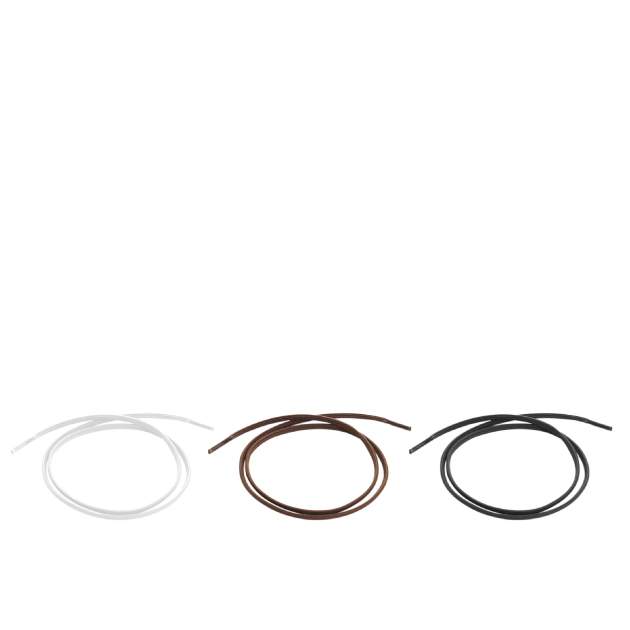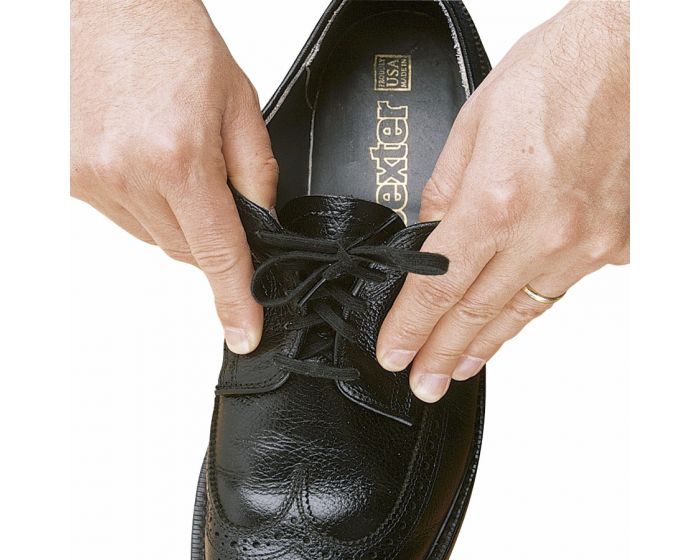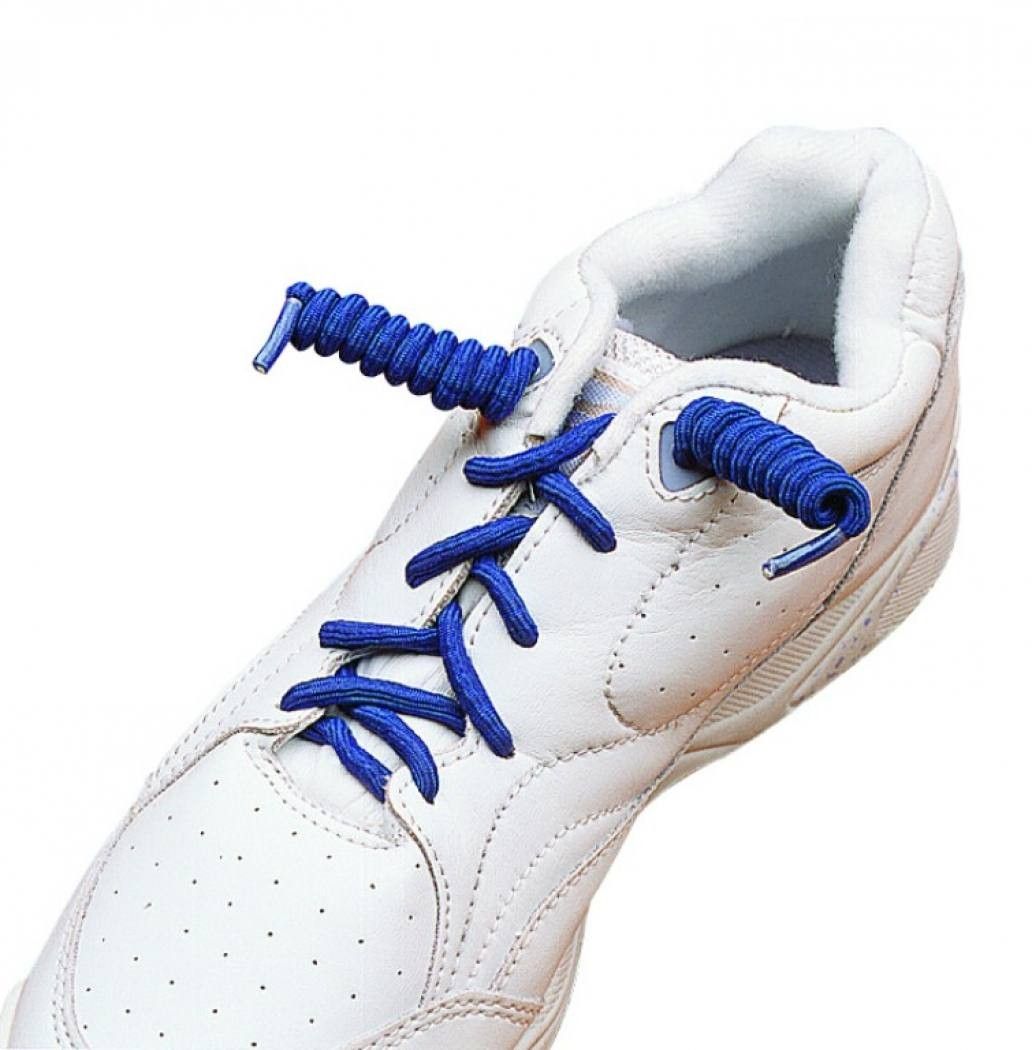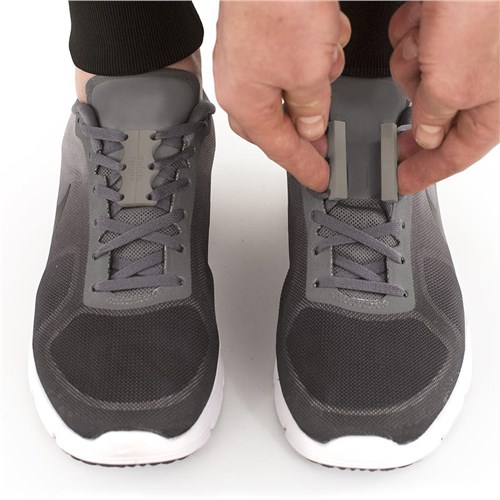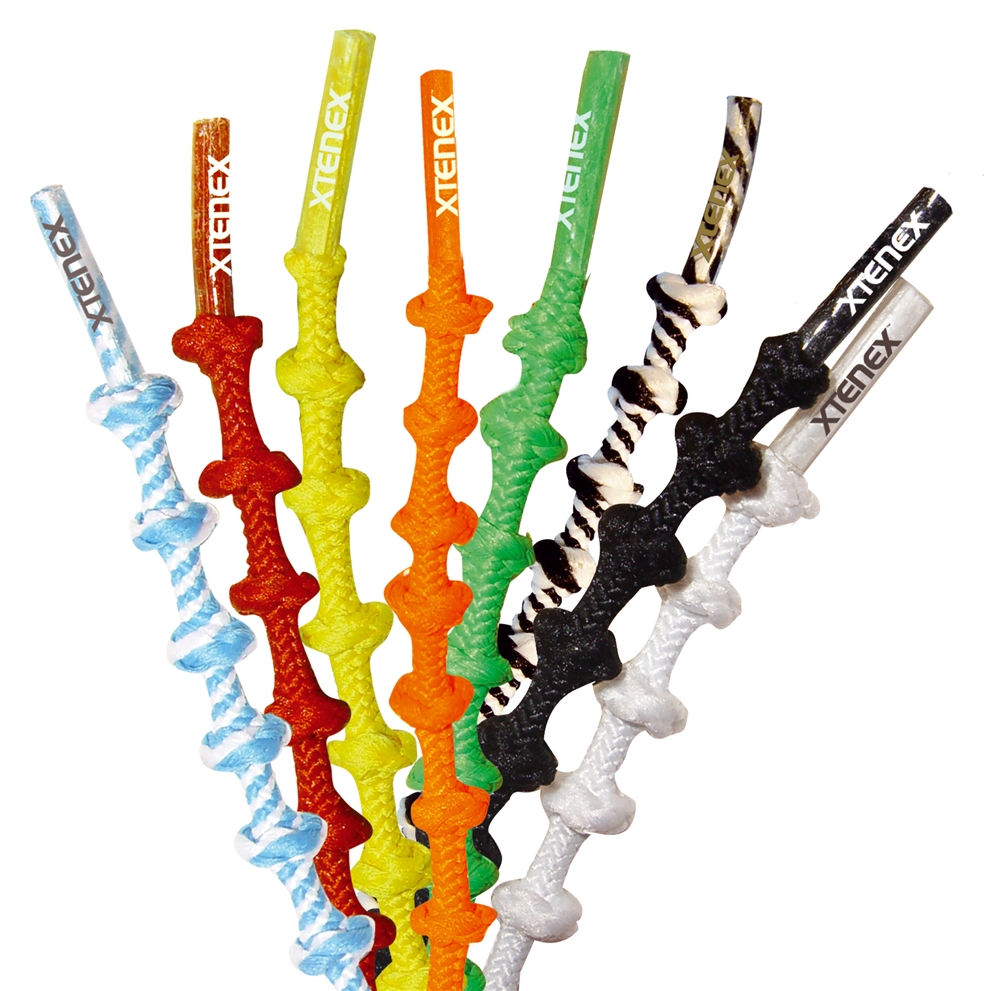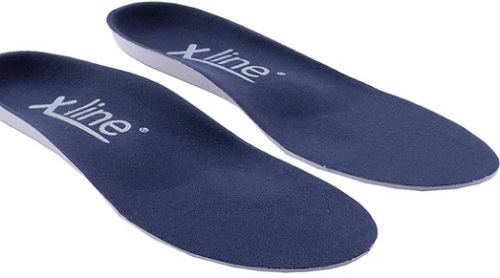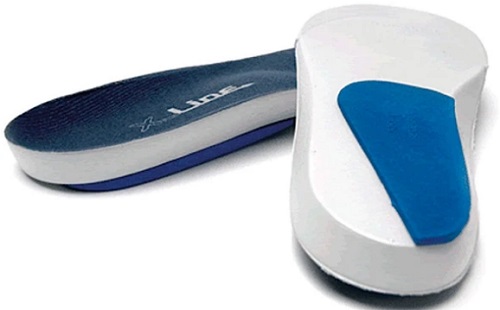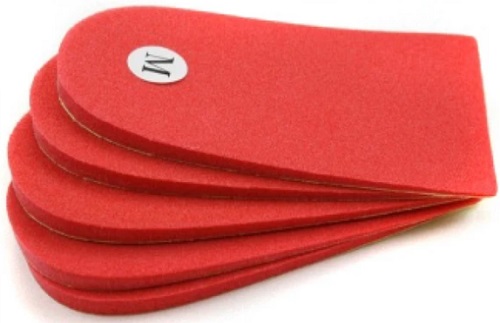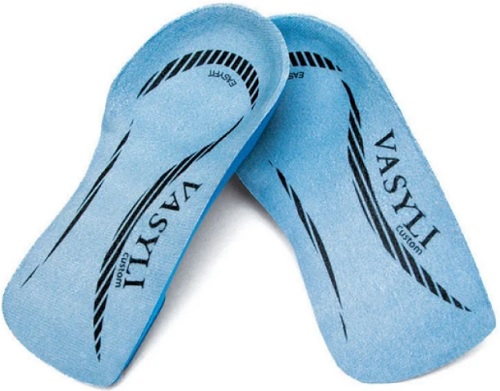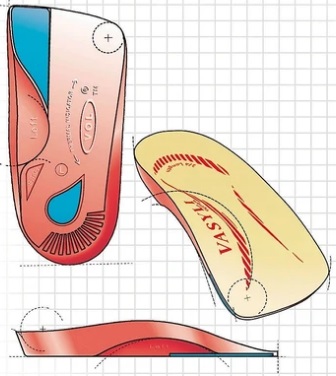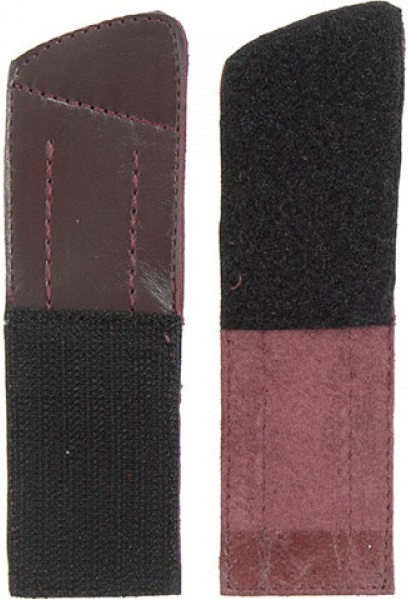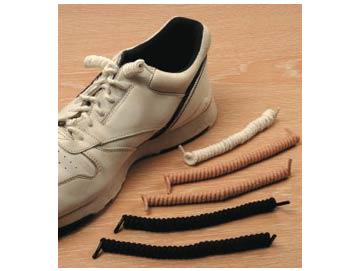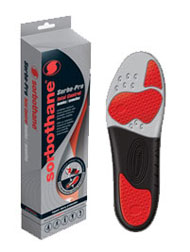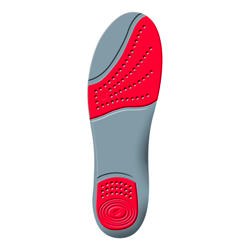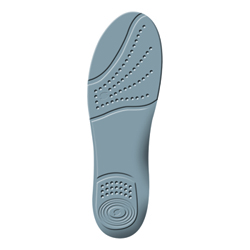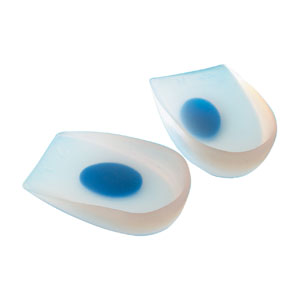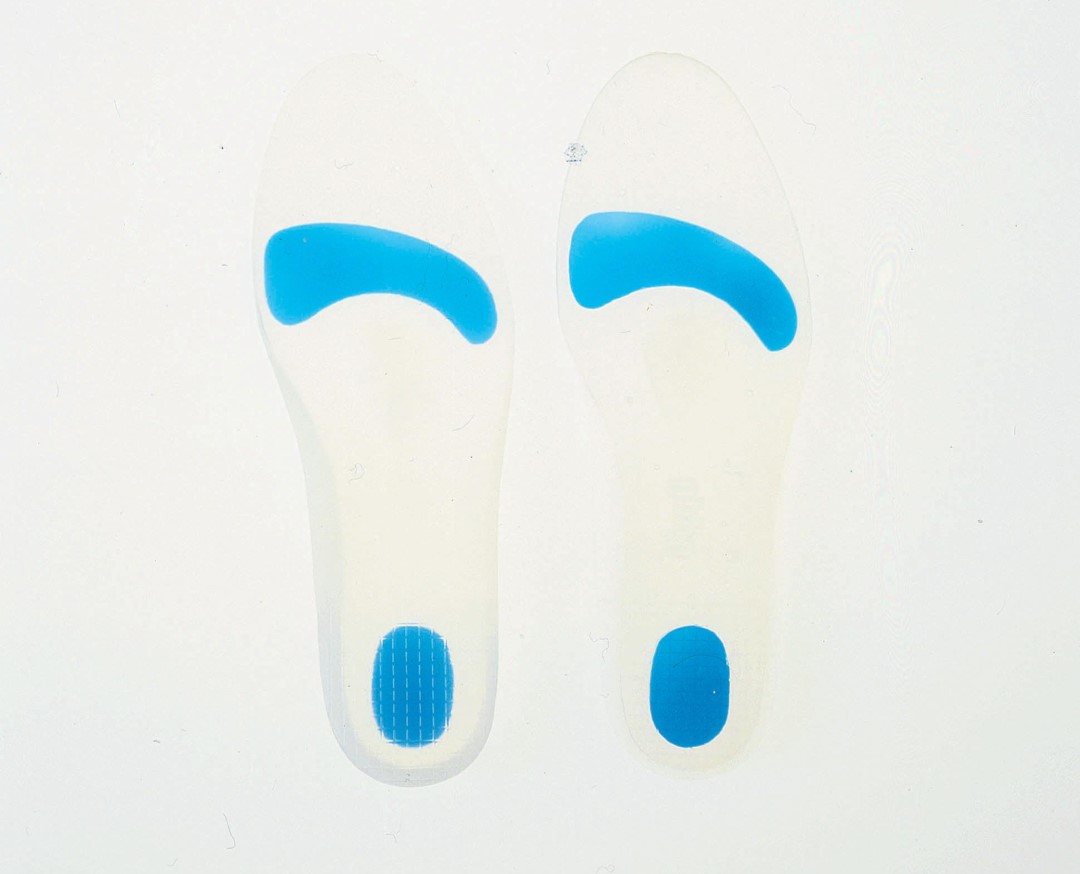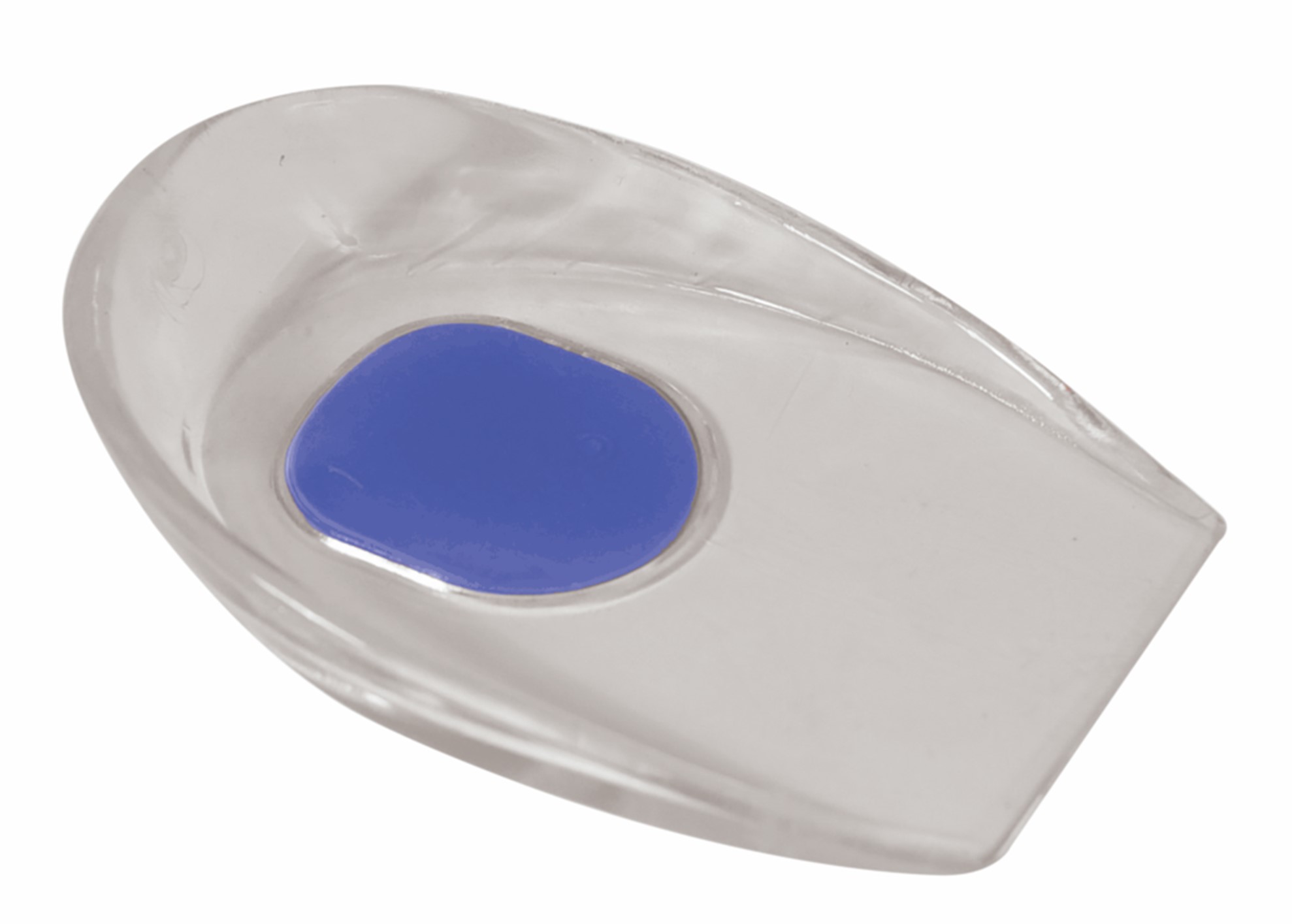Insoles, extensions and laces
This section includes insoles, laces and extension fastenings for footwear. They are suitable for adults, children or both. Some are made-to-measure.
Inserts and insoles for support are placed inside your shoes. They provide some support and alignment to your heels and/or mid-foot.
Inserts and insoles for comfort are placed inside your shoes. They provide cushioning to your heels, mid-foot and/or forefoot.
Elastic laces replace ordinary laces and enable shoes to be slipped on and off without the need to bend down and fasten or unfasten the laces. This may help if you have difficulty bending low to fasten your shoes, or if you have reduced strength or dexterity in your hands. When slipping shoes on, ensure the tongue of the shoe is secured so that it will not slip inside the shoe. Some are coiled, these do not need to be tied like regular laces and can be pulled with one hand to tighten them. Others require fastening like standard shoe laces, however can be left fastened while the shoe is slipped on and off.
Lace locks enable shoes to be fastened and unfastened independently if you have reduced dexterity or strength in your hands, or the use of only one hand. They eliminate the need to tie shoelaces, and are usually slid onto laces to tighten them and released by pinching the buttons on either side.
Extension fastenings enable an existing fastening on footwear to be extended. They are generally for strap or flap types of fastener, with Velcro or a buckle. Extending fasteners may make them easier to grip if you have limited grip or dexterity in your hands.
Introduction
Everyone wants to be able to choose and wear footwear that is comfortable and to their own personal taste. This can be difficult for you if you need particular footwear, or you have difficulty managing your footwear when you are getting dressed and undressed.
There are companies which specialise in manufacturing footwear to meet particular needs and some elements of footwear can be adapted. Certain types of fabric and styles of footwear can be useful in overcoming problems. Dressing equipment and techniques can be utilised to enable ease and independence in self-care.
For information about our help services, or for a list of other useful organisations and information resources, please see the end of this factsheet.
Choosing suitable footwear
Choosing the right shoes is important: they provide your feet with support and stability and protect your feet from the environment. Choosing the wrong type or size of shoe can be damaging to your feet, or can make existing foot problems worse.
Footwear should be fitted by staff who have been trained in measuring and fitting feet. If you are concerned, ask to see a current certificate of membership of a trade association, e.g. Children’s Foot Health Register, or certificates of training for individual staff members.
If you have a condition that requires you to wear special footwear, you should always follow the advice of your doctor, podiatrist (also known as a chiropodist) or other healthcare professional. A podiatrist is a specialist in the diagnosis and management of disorders of the foot, ankle and lower limb.
The following advice for fitting and selecting shoes is provided by the Society of Chiropodists and Podiatrists:
- Make sure there is 1cm (1/2 inch) of space between your longest toe and the end of the shoe - this can easily be checked by pressing the upper of the shoe to locate the position of your toes
- Check there’s enough room for your toes to wiggle in the shoe
- There should be enough width in the shoe to accommodate your whole foot - there should be no pressure on the joints on the sides of your foot
- For comfort, shoes shouldn’t slip at the back. If the shoe slips when you walk, push your heel to the back of the shoe, then try altering the laces or straps to improve the fit against your foot.
What to look for in a shoe
To help prevent damage to your feet, try to apply the following rules when you buy shoes.
- Heel - this should have a broad base and should be no greater than 4cm (1½ inches)
- Heel counter - this reinforces the heel cup and stabilises the foot upon ground contact. (A firm heel counter helps lock the foot into the shoe and anchors it to the mid-sole.)
- Heel collar - this should pass under the ankle, padding may help reduce the pressure on your ankle and reduce the chance of blisters developing
- Sole - this should provide cushioning and protection for comfortable walking and enough grip to prevent slipping
- Upper - ideally made from natural materials such as leather or breathable fabrics to keep feet comfortable
- Linings - breathable materials such as leather or fabric to keep the foot fresh; they need to be smooth and seam-free
- Fastenings - laces or straps with buckles or touch fastenings (hook and loop) help to hold the foot securely within the shoe
- Toe Box - sufficient depth to prevent rubbing and allow toes to wiggle
- Insole - preferably removable to allow easy insertion of padding or orthoses
Footwear styles and fabrics that might help your needs
If you have difficulty bending down, gripping and manipulating small items, you may struggle putting on and taking off footwear. You can look for styles which simplify the process of getting footwear on or off, avoiding fiddly fittings. You can also look for designs and materials which add to the comfort of your footwear, whilst still having support and safety.
- Slip on shoes can be easier to use, but they are not advised if you wear an orthosis as they are generally shallow fitting and may not provide enough depth for the foot and orthosis at the same time. Hook and loop fastenings may be useful for some people. Make sure that the shoes still grip your feet adequately for support and safety
- Ensure footwear holds your foot well enough that your shoes or slippers do not unintentionally slip off your feet
- Ensure your foot is held back in your footwear, so that your foot does not move forward crushing your toes
- If you get cold feet, look for footwear with thick soles and warm linings, such as wool and fleece. Use multiple layers to trap the warmth
- If you are someone who gets sweaty feet, try footwear made of natural fabrics, or those that allow your feet to breathe
- Footwear made of fabric that has an element of stretch can help when you want to avoid rubbing or putting pressure on certain areas of your feet
- If you might need to wash footwear, look for easy care fabrics.
Other types of footwear
Slippers
Slippers are often worn around the house because they are warm and comfortable. They should be reviewed and renewed regularly, as they stretch and wear quickly. Poorly fitting slippers can cause falls. If you are indoors for long periods of time, slippers may not be the most appropriate shoes to wear for the health of your feet. A well fitted comfy shoe reserved for indoor use is a good alternative.
Boots
Boots are available in a wide variety of styles and leg lengths. When buying boots it is a good idea to check how easy they are to put on and take off. You should also make sure they are not too tight around your calf or ankle, as this might restrict circulation.
Sandals
These are often worn in the summer months. It is a good idea to choose styles that have adjustable straps or buckles, particularly if your feet are prone to swelling. If you have diabetes, you should be careful if using sandals as your feet are not as protected against damage. Ensure that all of your foot, including your toes, is held within the edges of the sandal.
Dressing techniques
There are a range of dressing techniques that can be used depending on what difficulties you have. For example, there are one-handed dressing techniques for tying shoelaces, or for dressing if you have limited strength in your hands, or limited shoulder movement.
These dressing techniques can be demonstrated by an occupational therapist, who can advise you.
You may also be able to get advice on dressing techniques by visiting your local Equipment Demonstration or Independent Living Centre. There are several of these around the country where you can go for impartial advice. If you require further assistance in finding your nearest Equipment Demonstration Centre, call DLF's helpline on 0300 999 0004 or contact your local authority.
Dressing equipment
There is a range of equipment available to assist with a variety of dressing tasks. We recommend that you seek advice from an occupational therapist before buying equipment, or try them out at your local Equipment Demonstration or Independent Living Centre.
For some of these items, practice and correct technique is needed to ensure you can use them effectively.

Reachers and pick-up sticks
Reachers are available in various lengths and grip styles and have a pincer grip at one end.
They may be used to pick clothes up from the floor, pull up underwear or trousers and push down socks, underwear or trousers.
Some have a shaped pincer end which doubles as a shoe horn.

Shoe horns and boot removers
A long handled shoe horn may assist you if you cannot bend to put on your shoes. It will help keep the back of the shoe open while you slide your foot in.
A boot lever can help you remove high-legged boots.
There is usually a V shaped notch and the heel of the boot is placed into the remover while you ease your foot out of the boot.
Zip aids or zip pullers
A zip aid is usually a piece of cord or fine chain with a hook on one end and a tab at the other to assist with doing up zips. Large rings or tape can also be attached to a zip tab to help make gripping easier. Consider these if you have zips on boots.
Sock, stocking and compression stocking aids
Sock and stocking aids may help if you have difficulty bending forwards to put on socks, stockings, tights and compression stockings. There are a variety of flexible and rigid styles and most require a degree of grip strength and dexterity. There are also stocking aids specifically designed for putting on compression stockings.
An occupational therapist would be able to advise you on which one is most suitable for you.
Flexible stocking/sock aid
The flexible version is cone shaped and made of plastic, fabric-covered plastic or just fabric. It has two tapes/ribbons at the top. It is sometimes called a gutter sock aid.
With the aid held on the knee, the sock is gathered onto the aid which keep the sock open along its whole length. The aid is then lowered onto the floor, whilst holding on to the tapes. The toes of the foot are placed into the open end of the sock and the ribbons pulled to pull the sock up the lower leg.
The fabric, or fabric-covered type, are recommended to anyone who has delicate skin.
A double version of this aid can be used for tights. These are rather tricky to manipulate and require a lot of practice especially if there is a high lycra content in the tights.
People with poor grip or shoulder function may find pulling the tights up over the hip difficult. Pulling up with hands crossed over the body reduces the amount of shoulder movement required.
Rigid stocking/sock aid
The rigid version consists of a plastic semi-circle which pivots on the end of a long handle. As with the flexible sock aid, the sock is fed onto the aid which keeps it open. The toes of the foot are then placed into the open end of the sock and the aid used to pull the sock up the lower leg.
Sock aid frames
These are rigid wire frames which hold the sock open whilst the foot is placed into the sock. The frames usually has handles at the side which are used to pull the frame and thereby the sock up the leg.
Compression stockings
The sock aid frames are usable with compression stockings. Hand strength is required to load the stocking on to the frame.
If you wear the toeless stockings, you can get a stocking slider, which is made from slide sheet fabric which helps to slide the stocking on smoothly past the toes and heel. There are also some slide-sheet fabric aids designed for enclosed toe stockings.
Be aware that when using the slide sheet stocking gadget you need to be able to reach down to your feet.
These gadgets may help a carer to assist with dressing if the wearer’s skin is delicate.
Shoelaces and lacing aids
Lace locks can be used to tighten and loosen laces without the need to tie them.
Elastic laces can be used to convert lace up shoes into slip-ons.
Coiled laces can replace standard laces, and can be tightened using only one hand.
Footwear for specific conditions
If you have a specific significant problem related to your feet which changes your gait (the way that you walk), it is important that you seek professional assessment, as it may be helped by an orthotic shoe or insole. These change and/or stabilise your foot positioning and can thereby improve your gait.
Speak to your GP initially, who will be able to refer you to the most appropriate service if necessary, or you can access these services privately.
There are a number of professionals who look at your gait, the health and care of your feet and your footwear. You should have a full assessment, perhaps first by a physiotherapist or podiatrist. You may also see a biomechanic or an orthotist.
Prescribed orthopaedic footwear or insoles should be available through the NHS, but waiting times can be significant. Private orthotics services will charge for the assessment and the provision of any insoles, supports or footwear.
Your normal footwear may be adaptable to cater for some specific needs.
Arthritis
People with arthritis often have a great deal of trouble with their feet if bony changes take place, e.g. when the bones of the toes cross over, or the ends of bones lose all their fatty protection.
The ideal footwear should have insoles with good shock absorption, thick but flexible soles to protect the feet from the ground underneath, plenty of depth to accommodate the toes, soft uppers of leather or fabric and lightweight soles and heels. Trainers often fit this description and can be a sensible choice when the condition first makes itself felt.
Shoes with extra depth may be needed. Some mail order catalogues specialise in shoes with extra depth and some will make to your measurements.
Socks with extra padding over the sole of the foot will provide better cushioning, but make sure footwear does not then become too tight.
Arthritis Research UK's website provides some useful research information and people's’ experiences when looking for shoes.
Bunions
Look for footwear styles which relieve the pressure on your toes and inner side of your foot. Try a style which holds your foot well back within the shoe and avoid styles which raise your heel above your toes, so preventing downward pressure on your toe joints. Footwear which has soft leather or textile uppers with the minimum of seams will be more comfortable. The inside edge should be as straight as possible with plenty of room around your toes.
Cold feet and circulation problems
People who have very little movement or poor circulation can find it difficult to keep their feet reasonably warm. Thick soled shoes and additional insoles help insulate feet from the cold. Shoes should neither be too tight nor too loose - both can cause cold feet. See the section above on hosiery for people with circulation problems.
Constantly cold feet may lack sensation. The skin needs inspecting regularly for bruising, breaks or infection.
Hosiery for people with circulation problems
Certain conditions like diabetes or Raynaud’s can cause circulation problems, especially to the hands, lower legs and feet. It them becomes important to protect your hands and feet from cold and possible damage which you may not feel.
Consider wearing two pairs of socks, one thick and one thin or socks over stockings. These must fit properly within the shoes - they shouldn't be too loose nor too tight.
Diabetes UK recommend that you avoid socks, stockings or tights with wrinkles or prominent seams. Garters and stockings or socks with elastic tops should also be avoided because they may restrict the circulation. Never wear socks with darned areas or holes.
Mountaineering or walking socks (available from sports shops) are often warmer than traditional socks. Slipper socks have extra grip soles, cover the foot and reach the calf. They are worn instead of slippers and shoes but are not as supportive. They are safer and warmer than ordinary hosiery worn without shoes, but may prove difficult to remove.
Hosiery is available in a wide range of material and in different weights. Man-made fibres feel warmer when they have a brushed or terry finish. The thicker the fibre the warmer it is, particularly when knitted. Wool is a good insulator but needs washing carefully and replaced when the fibres become matted. Silk is also known for its warmth when layered and silk socks are available from outdoor pursuit suppliers.
Diabetes
People with diabetes need to look after their feet very carefully. Diabetes UK have some online information on taking care of your feet and everyday footcare.
Diabetes UK recommend that you buy shoes that:
- are broad fitting
- have a deep and rounded toe area
- are flat or low heeled
- are fastened by a lace or buckle to keep the heel in the back of the shoe: the foot can then not slide forward and crush the toes at the end of the shoe.
Excessive perspiration
If you have very sweaty feet:
- look for footwear that allows your feet to ‘breathe’
- use insoles which you can replace or wash on a regular basis
- swap between your shoes often, leaving shoes for at least 24 hours after being worn, drying and airing them properly
- footwear made of porous, breathable material such as leather, or materials which have been treated, such as Gore-Tex, may help to alleviate the problem
- check the composition of the shoe lining to make sure it is also breathable
- wellington boots are also available in breathable material
- Try to avoid using purely synthetic socks, but look for those with a higher mix of natural fibres, or you may want to consider trying socks which are designed to wick damp away from the feet.
Sensitive skin
The chemicals used to tan leather can cause allergic reactions, as can some dyes or material used in constructing shoes, such as rubber and adhesives. Some leather is tanned in different ways, or using natural products, and may not cause a reaction. Some minor allergies to leathers or dyes can be avoided by choosing shoes with a cotton lining, or by wearing cotton socks. Shoes made from fabric are also an option depending on the nature of your allergy, but check the materials used.
You are advised to seek a dermatology (skin) test to identify what chemical or material you are sensitive to, as this will guide your future choices. Manufacturers may provide information on any chemicals or materials used in the structure or manufacturing of their shoes on request.
Wellington boots are sometimes a problem for people who have an allergy to rubber. Some are available lined in cotton. Breathable Wellington boots are also available.
Soles and insoles are made from many different materials. If you are sensitive to a particular material, you may be able to replace them with a more suitable alternative.
Swollen feet
Feet and ankles can become swollen for a variety of reasons, either for short or long periods. The swelling, or oedema, is caused by a build-up of fluids in the tissues of the lower leg, ankle and foot.
Short-term swelling of the feet may be the result of an accident or an operation. This will usually disappear following treatment, as movement and mobility returns. It can be caused by a long bus or plane journey. Travellers should choose adjustable footwear for comfort, and may consider wearing compression stockings or ‘flight socks’ for travel.
Long term swelling of the feet often accompanies conditions such as heart disease, or when people have less mobility and are seated for long periods. It can also accompany obesity. Any swelling often worsens towards the end of the day.
The degree of swelling can be decreased by raising the feet for periods during the day, accompanied by as much exercise as possible - movement of the calf muscles encourages the return of blood to the heart and so helps to minimise the retention of water in the feet and legs.
When buying shoes, particular care should be taken with fitting. You may be particularly vulnerable to skin damage so your shoes need to give you good support, be well-fitting and have a smooth lining. They should not be bought when your feet are at their most swollen. You may opt to have morning and evening shoes, which should be bought at the appropriate times. If you are unsure, it may be a good idea to be fitted by someone who has had appropriate training, through an organisation such as The Society of Shoefitters.
You may prefer summer sandal styles, as they are often made of fabric, are light or stretchy, and have lots of gaps or holes. During cold weather you should check the condition of his/her skin and may need to wear warm socks or tights to protect against the cold. Many sandals have buckles or laces which enable the shoe to be enlarged easily, both round the ankle and over the front of the foot. Some straps or buckles are attached with elastic and longer lengths can be sewn on.
Shoes and socks/stockings should be put on before the feet are placed on the ground and before they have become swollen. The use of a long-handled shoe horn may be helpful.
If you have swollen feet, you may require special footwear with extra depth and possibly width. Look for footwear that has a heel with a broad base, an adjustable fastening such as laces or hook and loop Velcro, a supportive upper and slip resistant sole. Avoid higher heels and loose slippers. Surgical/orthopaedic firms produce ready made shoes with extra depth which have a variety of insoles to cope with the fluctuations of swelling.
Footwear designed for use over dressings and plaster-casts may provide a cheap solution to the problem of what to wear indoors.
Post-surgery footwear may also be useful for you if you have heavily bandaged feet.
If you are being seen by community nursing services, they may be able to provide these for you.
Socks, stockings and tights for swollen feet
Socks without elastic at the top may be easier to wear if legs are swollen. Some specialist suppliers stock socks for swollen feet. Stump socks made for amputees are sometimes suitable for swollen feet and are available from specialist suppliers.
Tube socks, often used for skiing, avoid the problem that the heel may be in the wrong place if the foot is swollen, although sometimes the lack of shaping increases pressure at the front of the ankle. Most sports shops stock these socks.
Support tights and stockings may help by providing venous support and can be bought from high street stores. Advice should be sought from retail pharmacies or through the local health centre about the correct pressure needed.
Compression hosiery also provides support. It is generally prescribed and fitted by practitioners trained to offer guidance on the wearing of compression hosiery, as the compression will vary at specific points along the leg. Getting these stocking on and off can be difficult. If so, discuss the problem with a healthcare professional, or with your nearest clothing advice service, to find out about dressing techniques and equipment that may help.
Footwear for odd-sized feet
Most people have feet which are slightly different in size. Some people with odd-sized feet may have one foot at least two sizes longer and/or wider than the other.
Obtaining different sized shoes
The NHS does not prescribe footwear for odd sized feet unless there is a medical reason for such a prescription.
You can purchase odd-sized shoes in a number of ways.
- If you are buying two pairs of different sizes, some shops give a discount off the second pair. Ask the manager if this is possible
- Some shops provide pairs of shoes in odd sizes but may add a surcharge. One pair of shoes is sold made up from two existing pairs, either by the retailer or the manufacturer. This is usually most successful in black. If the shoes are made from different skins the shoes may differ in colour and texture
- Placing a special order - the retailer orders two shoes of different sizes from the manufacturer who makes them up on the appropriate standard lasts using a single skin. This gives the resulting pair consistency of texture and colour.
Shoe-swap organisations
There are a number of organisations which host shoe-swap websites for both adults and children.
Mail order companies
A number of small companies making shoes are able to supply odd-sized shoes by mail order. The customer draws a footplan of both feet in accordance with the firm's order form.
Some mail order companies supplying off-the-shelf footwear may sell shoes of two different sizes and single shoes.
Mail order is not recommended for children as they need the personal attention of a skilled fitter.
For a child or adult who has feet which vary greatly in length, perhaps one foot is child-size and the other adult, made-to-measure bespoke footwear may be the only answer.
The less expensive method for adults is for the footwear to be made on a personalised last (a solid model with a similar shape to the foot). The main expense is the construction and keeping of the last for each foot. The cost of the first pair will therefore probably be greater than it will for subsequent pairs.
Fitting feet of different widths
A small difference in foot width may be accommodated by buying footwear with adjustable fastenings, i.e. laces, buckles or Velcro. The footwear should be bought to the larger width. Footwear made of very soft leather or of fabric will mould more easily.
An insole in the shoe of the narrower foot may help, although it may also decrease the depth of the shoe as well as its width. People who make hand-made shoes, the uppers of which are cut out to normal commercial sizings, may be able to mould the upper to accommodate small differences.
Large differences will probably have to be dealt with by made-to-measure bespoke footwear.
Orthopaedic footwear for different sized feet
If someone, in addition to having odd sized feet, has a medical condition requiring specialist footwear, it will be prescribed by a hospital consultant. The footwear is fitted by the hospital orthotist and supplied by an authorised NHS contractor.
Some manufacturers of children's ready-made orthopaedic footwear will supply odd sizes. These bootee styles are usually supplied for children who need straight lasted styles or ankle support.
However, they are similar in style to those found in high street shops and may be acceptable to children whose only problem is their odd sized feet. Names of the firms supplying such footwear are available via a web search or from the DLF helpline. They can be checked with the British Healthcare Trades Association if desired.
Footwear adaptations
Some people have footwear prescribed for them on the National Health Service (NHS). People needing such footwear must be referred by their general practitioner and must have a medical reason for the prescription. People who have been given a prescription will be provided with either ready made or made-to-measure footwear.
If prescribed by a hospital consultant, shoes can be adapted free on the NHS; otherwise the adaptations may be undertaken and paid for privately. An orthotist - the person employed to carry out the prescription - will run a footwear clinic in the hospital. Orthopaedic shoemakers will also undertake this work privately, e.g. for people who want additional shoes adapted. The number of shoes that can be adapted on the NHS will vary. You are advised to confirm this with your local service.
Any shoe that needs adapting should be of reasonable quality and well made. To make some adaptations the shoe will have to be taken to pieces and re-made - a poorly constructed shoe may not be able to withstand this.
Certain styles of shoe are more suitable for adaptation than others. Ask your orthotist what qualities are required, so that you can explain to the shoe shop exactly what you need from the shoes. Adaptations cannot be made to trainers with air cells, footwear with hollow or moulded sole units, footwear with soles that extend up the sides of the upper and footwear with soles other than leather stitched to the upper (Sheffield Teaching Hospitals, 2016).
The adaptations most usually prescribed are:
- Shoe raises
- Calliper sockets
- Change of fastening/s.
Understanding your needs
It is important for you to fully understand your condition or circumstance so that you are able to choose and/or adapt footwear to meet your needs. The more information you hold about your personal circumstances and what works for you, the more confident you will be in seeking out or asking for suitable items and adapting them if necessary.
If you have a condition that requires you to wear special footwear, you should always follow the advice of your doctor, podiatrist or other health care professional.
In most cases, you should discuss your problem with your GP first. Your GP can refer you to a local NHS podiatrist, or can refer you to a private podiatrist in your area.
If you would like to find a podiatrist yourself, make sure they are registered with the Health Professions Council and are a member of either:
- The British Chiropody and Podiatry Association
- The College of Podiatrists or
- The Institute of Chiropodists and Podiatrists.
Supply and provision
Unless you have specialist footwear that is prescribed, it is not usually supplied by statutory services. If the particular shoes that you require are costly, you may want to apply for alternative charitable funding. Speak to an appropriate professional first to clarify what you need, as most applications require the support of a qualified health or medical professional. There are a number of charities who offer grants for adults and children.
Funding sources
Children
Before you seek charitable funding (or buy) equipment for your child, we would advise you to seek specialist advice. This will help you plan for both immediate and long term needs, increase awareness of the alternatives on the market, and to check whether the equipment you need can be provided by the statutory services (if this hasn't already been investigated).
The Directory for Social Change (DSC)
The DSC is an organisation which aims to support charities. They have an service which charities or other bodies can subscribe to find and access grant monies.
Disability Grants
Disability Grants offers help in finding grants.
Family Fund
Family Fund provides grants for families raising disabled or seriously ill children and young people aged 0-18. They provide grants for a wide range of items, including clothing.
Masis
Provide grants and financial support advice.
My Grants
Blogging/chat site with general advice concerning accessing grants.
Turn 2 Us
A national charity that helps people in financial hardship gain access to welfare benefits, charitable grants and support services.
